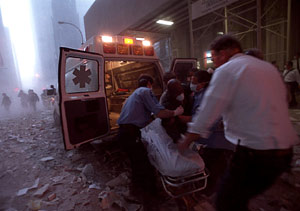
The day after the attack, the sun rises over where the World Trade Towers stood in lower Manhattan
(7 of 11)
404 Not Found
Major Reginald Mebane, who heads security for one of the state court buildings, organized a group of about 10 officers. They grabbed some medical equipment and hopped a court bus to help evacuate people. But when one tower began to collapse, they raced for cover inside Building Five of the Trade Center complex. The smoke made it so dark they could see only a few feet in front of them, even with flashlights. They felt their way along the walls and windows to get out. "The building just blew," says Bill Faulkner, 53, a Vietnam veteran who was part of the group. "I would be dead if I hadn't jumped behind a pillar." Another court officer, Ed Kennedy, who also hid behind the pillar, says he grabbed the arm of a woman in an effort to pull her behind the pillar with him. But he didn't grab her fast enough. Suddenly he realized he was holding just an arm. It was only when a fireman broke the window in the Borders bookstore that the men were able to escape.
Fire fighters pushed people further back, back up north. Mayor Giuliani took to the streets, walking through the raining dust and ordering people to evacuate the entire lower end of the island. Medical teams performed triage on the streetcorners of Tribeca, doling out medical supplies and tending the walking wounded. Doctors, nurses, EMTs, even lifeguards, were recruited to help. Volunteers with the least training were diverted to blood-donation centers or the dreaded "black teams," where they would not be called upon to save a life, just handle dead bodies during triage. The color code: black for dead, red for immediately life-threatening wounds, yellow for serious, non-life threatening and green for the walking wounded. Police and fire fighters realized even as they worked that hundreds of their colleagues, the first to respond, were dead. Each looked as if someone had kicked him in the stomach. A looter was arrested: he had two fire department boots on his feet, and the cops looked as if they were going to kill him.

ANDRADE PATRICK/GAMMA
|
The refugee march began at the base of the island and wound up the highways as far as you could see, tens of thousands of people with clothes dusted, faces grimy, marching northward, away from the battlefield. There was not a single smile on a single face. But there was remarkably little panic as well--more steel and ingenuity: Where am I going to sleep tonight? How will I get home? "They can't keep New Jersey closed forever," a man said. Restaurant-supply companies on the Bowery handed out wet towels. A cement mixer drove toward the Queensboro Bridge with dozens of laborers holding onto it, hitching a ride out of town. Overcrowded buses, one after another, shipped New York's workers north. Ambulances, some covered with debris, sped past them, ferrying the injured to the waiting hospitals.
All over the city, people walked with radios pinned to their ears. One man had the news on his car radio turned up as close to 100 people surrounded the car listening to the reports. Just before noon, a radio commentator said, "Inarguably, this is the worst day in the history of New York City." No one argued.
Churches opened their sanctuaries for prayer services. St. Bartholomew's offered water and lemonade to everyone passing by. The noon Mass at St. Patrick's was nearly full. "We pray as we have never prayed before," said Monsignor Ferry. "Remember the victims today. Forgive them their sins, and bring them into the light." Posted defiantly in every window of one restaurant was the sign WE REFUSE TO GIVE IN TO TERRORISM. CIBO IS OPEN FOR BUSINESS. GOD BLESS AMERICA. A well-dressed man in a suit sat on a bench in Central Park, his head bowed, his hands clasped between his knees. A carousel of quiet toys turned in the darkened windows of FAO Schwarz.
There were no strangers in town anymore, only sudden friends, sharing names, news and phones. Lines formed, at least 20 people long, at all pay phones, because cell phones were not working. Should we go to work? Is the subway safe? "Let's all have a good look at each other," a passenger said to the others in her car. "We may be our last memory." The passengers stranded at La Guardia Airport asked one another where exactly they were supposed to go and how they were to get there. Bridges, tunnels and ferries to Manhattan were not running. Strangers were offering each other a place to wait in Queens, giving advice on good diners in Astoria. Limousine drivers offered to take passengers to Boston for a price. A vendor dispensed free bottles of water to travelers waiting in the hot sun.
